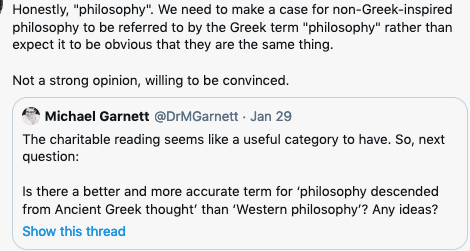What I today call philosophy of ritual comprises a complex set of philosophical approaches seeking to solve questions and problems arising in connection with ritual. Different philosophers of ritual aim at reconstructing rituals in a highly structured, rigorous manner, curbing religious metaphors to the strict discipline of their linguistic analysis. As a result, they examine religious texts according to exegetical rules to extract all meaning and intelligibility from them. Another set of philosophical questions connected with rituals concerns duty. How are duties conveyed? How can one avoid contradictions within texts prescribing duties? I started using deontic logic, as initially developed by G.H. von Wright, to formalise contrary-to-duty situations and think about commands, especially thanks to the collaboration with the amazing Agata Ciabattoni and her brave team at the Theory and Logic Group of the TU in Vienna. Ciabattoni had not heard of logic apart from the Euro-American mathematical logic. Before meeting her, I had not heard, let alone worked on intuitionistic logic nor on fuzzy logic. By joining forces, we could explore new formalisations to make sense of seemingly puzzling texts (see mimamsa.logic.at).
Working with people outside one’s comfort zone is demanding, since one cannot assume any shared research background and needs to explain each element of one’s research. However, exactly this deconstructive operation means that one needs to rethink each step analytically, often being able to identify for the first time problems and resources one had overlooked.
For instance, our ongoing work on permissions in ritual is going to highlight the advantages of the Mīmāṃsā approach in denying the interdefinability of the operators of permission, prescription and prohibition and thus avoiding the ambiguity of the former (which in common linguistic use as well as in much Euro-American deontic logic can mean “permitted, but discouraged”, “permitted and encouraged” as well as “permitted and neutral” and in Euro-American deontic logic even “permitted and prescribed”). By contrast, permissions in Mīmāṃsā are always “rather-not” permissions, whereas what is encouraged though not prescribed is rather covered by different operators.
Within the next weeks, I plan to put the finishing touches and submit to a publisher a first book dedicated to deontics and philosophy of ritual not in the Euro-American or Chinese worlds. The book, entitled Maṇḍana on Commands, aims at providing both scholars of philosophy and of deontics in general a comprehensive access to the thought and work of a key (but unacknowledged) deontic thinker and his attempt to reduce commands to statements about the instrumental value of actions against the background of its philosophical alternatives. I plan to continue working on deontics and philosophy of ritual with an intercultural perspective and with cross-disciplinary collaborations.
Within Philosophy of Religion, I aim primarily at using an intercultural perspective to rethink the categories of “god” and the connected category ofatheism”. Scholars who have not thought critically about the topic, might think that there is only one concept of “god” that is discussed within philosophy, and that this is the omnipotent and omniscient Lord of rational theology, whose existence is necessary and independent of anything They created. But this is not the case in European philosophy (especially in the parts of it which have been more influenced by Jewish philosophy) and it is certainly not so outside of European philosophy. For instance, Tamil and Bengali philosophers of religion will think about and worship a personal and relational God, one for whom existence is not intrinsically necessary, but dependent on His (Her) relation to His (Her) devotees. Similarly, looking at Buddhist authors allows one to see how atheism can be constructed in a religious context, namely as the negation of one (or multiple) concept(s) ofgod”, typically focusing on the negation of mythological deities and the contradictions they entail. I plan to submit a project on new ways to conceptualise atheism from an intercultural perspective and to continue working on the concept of a relational God, deriving my inspiration especially from Medieval Viśiṣṭādvaita Vedānta theologians like Veṅkaṭanātha.

